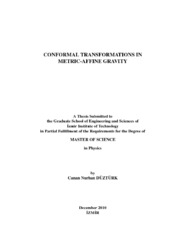Please use this identifier to cite or link to this item:
https://hdl.handle.net/11147/3453Full metadata record
| DC Field | Value | Language |
|---|---|---|
| dc.contributor.advisor | Demir, Durmuş Ali | en |
| dc.contributor.author | Düztürk, Canan Nurhan | - |
| dc.date.accessioned | 2014-07-22T13:51:33Z | - |
| dc.date.available | 2014-07-22T13:51:33Z | - |
| dc.date.issued | 2010 | en |
| dc.identifier.uri | http://hdl.handle.net/11147/3453 | - |
| dc.description | Thesis (Master)--Izmir Institute of Technology, Physics, Izmir, 2010 | en |
| dc.description | Includes bibliographical references (leaves: 53-57) | en |
| dc.description | Text in English; Abstract: Turkish and English | en |
| dc.description | vii, 70 leaves | en |
| dc.description.abstract | Conformal transformations play a widespread role in gravitation in regard to their cosmological and the other implications. In this thesis, the effects of conformal transformations on General Relativity comparatively in metric formulation and in metric-affine formulation are analyzed. In the metric formulation of General Relativity ( pure metric theory of gravity ), conformal transformations, like gauge transformations, add a new degree of freedom to the system - the conformal factor. In this sense, they change a frame to a new one involving an additional degree of freedom. However, this new degree of freedom turns out to be a ghost field in pure metrical formulation i.e. Einstein-Hilbert action. This possesses a serious problem since ghosts are manifestly unphysical. To overcome this problem, we explore conformal transformations in metric-affine formulation of General Relativity ( metric-affine theory of gravity ) in which the metric and connection are treated as independent variables from the scratch. In metric-affine formulation, there is no a priori relation between metric and connection, and thus, their transformations under conformal transformations do not need to exhibit the correlation present in pure metrical formulation. We thus exploit this fact by assigning different transformation rules for connection to have ghost-free Lagrangians. Firstly, we use the conformally invariant connection, while the metric changes as in metric formulation. After these transformations, there is no ghost field generated by conformal factor. Indeed, there appears no kinetic term of the scalar field (auxiliary field-nondynamical field). This result is not sufficient sufficient for us. Because the main goal of our study is the obtaining a conformally invariant theory for gravity with a dynamical scalar field. Then, we use the multiplicatively transforming connection. This transformation does not give the result corresponding to our aim. Finally, we find that if connection transforms additively yet differently than in metrical formulation, the ghost generated by the conformal factor disappears. Additionally, we discuss the physical implications of these transformation rules. | en |
| dc.language.iso | en | en_US |
| dc.publisher | Izmir Institute of Technology | en |
| dc.rights | info:eu-repo/semantics/openAccess | en_US |
| dc.subject.lcsh | General relativity (Physics) | en |
| dc.subject.lcsh | Gravitation | en |
| dc.subject.lcsh | Transformations (Mathematics) | en |
| dc.title | Conformal transformationsin metric-affine gravity | en_US |
| dc.type | Master Thesis | en_US |
| dc.institutionauthor | Düztürk, Canan Nurhan | - |
| dc.department | Thesis (Master)--İzmir Institute of Technology, Physics | en_US |
| dc.relation.publicationcategory | Tez | en_US |
| item.languageiso639-1 | en | - |
| item.fulltext | With Fulltext | - |
| item.openairecristype | http://purl.org/coar/resource_type/c_18cf | - |
| item.openairetype | Master Thesis | - |
| item.grantfulltext | open | - |
| item.cerifentitytype | Publications | - |
| Appears in Collections: | Master Degree / Yüksek Lisans Tezleri | |
Files in This Item:
| File | Description | Size | Format | |
|---|---|---|---|---|
| T000871.pdf | MasterThesis | 406.05 kB | Adobe PDF |  View/Open |
CORE Recommender
Page view(s)
70
checked on Jul 22, 2024
Download(s)
1,034
checked on Jul 22, 2024
Google ScholarTM
Check
Items in GCRIS Repository are protected by copyright, with all rights reserved, unless otherwise indicated.